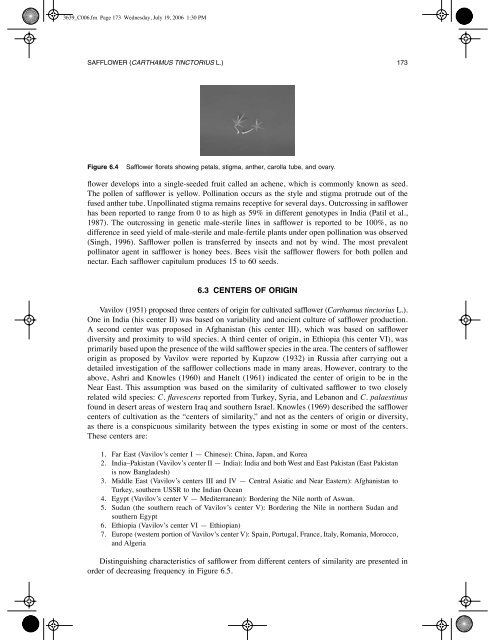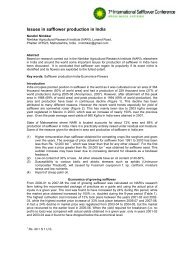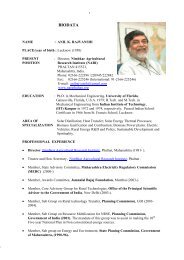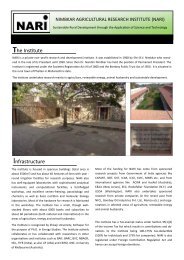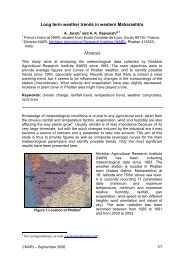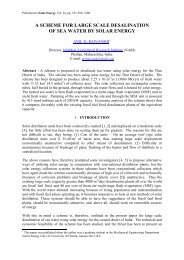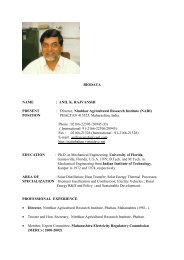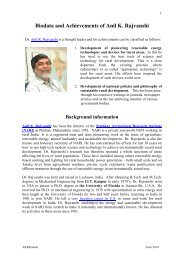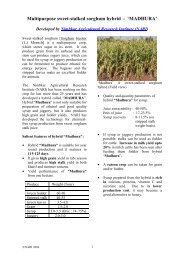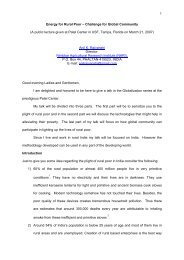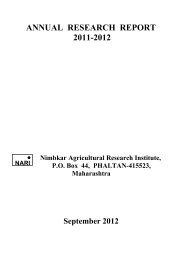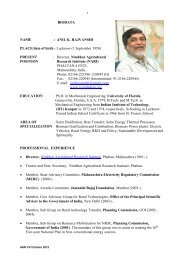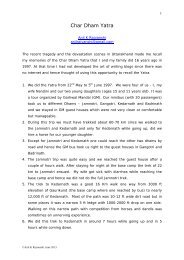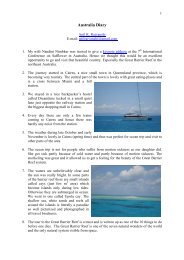Safflower (Carthamus tinctorius L.) - NARI
Safflower (Carthamus tinctorius L.) - NARI
Safflower (Carthamus tinctorius L.) - NARI
Create successful ePaper yourself
Turn your PDF publications into a flip-book with our unique Google optimized e-Paper software.
3639_C006.fm Page 173 Wednesday, July 19, 2006 1:30 PMSAFFLOWER (CARTHAMUS TINCTORIUS L.) 173Figure 6.4<strong>Safflower</strong> florets showing petals, stigma, anther, carolla tube, and ovary.flower develops into a single-seeded fruit called an achene, which is commonly known as seed.The pollen of safflower is yellow. Pollination occurs as the style and stigma protrude out of thefused anther tube. Unpollinated stigma remains receptive for several days. Outcrossing in safflowerhas been reported to range from 0 to as high as 59% in different genotypes in India (Patil et al.,1987). The outcrossing in genetic male-sterile lines in safflower is reported to be 100%, as nodifference in seed yield of male-sterile and male-fertile plants under open pollination was observed(Singh, 1996). <strong>Safflower</strong> pollen is transferred by insects and not by wind. The most prevalentpollinator agent in safflower is honey bees. Bees visit the safflower flowers for both pollen andnectar. Each safflower capitulum produces 15 to 60 seeds.6.3 CENTERS OF ORIGINVavilov (1951) proposed three centers of origin for cultivated safflower (<strong>Carthamus</strong> <strong>tinctorius</strong> L.).One in India (his center II) was based on variability and ancient culture of safflower production.A second center was proposed in Afghanistan (his center III), which was based on safflowerdiversity and proximity to wild species. A third center of origin, in Ethiopia (his center VI), wasprimarily based upon the presence of the wild safflower species in the area. The centers of safflowerorigin as proposed by Vavilov were reported by Kupzow (1932) in Russia after carrying out adetailed investigation of the safflower collections made in many areas. However, contrary to theabove, Ashri and Knowles (1960) and Hanelt (1961) indicated the center of origin to be in theNear East. This assumption was based on the similarity of cultivated safflower to two closelyrelated wild species: C. flavescens reported from Turkey, Syria, and Lebanon and C. palaestinusfound in desert areas of western Iraq and southern Israel. Knowles (1969) described the safflowercenters of cultivation as the “centers of similarity,” and not as the centers of origin or diversity,as there is a conspicuous similarity between the types existing in some or most of the centers.These centers are:1. Far East (Vavilov’s center I — Chinese): China, Japan, and Korea2. India–Pakistan (Vavilov’s center II — India): India and both West and East Pakistan (East Pakistanis now Bangladesh)3. Middle East (Vavilov’s centers III and IV — Central Asiatic and Near Eastern): Afghanistan toTurkey, southern USSR to the Indian Ocean4. Egypt (Vavilov’s center V — Mediterranean): Bordering the Nile north of Aswan.5. Sudan (the southern reach of Vavilov’s center V): Bordering the Nile in northern Sudan andsouthern Egypt6. Ethiopia (Vavilov’s center VI — Ethiopian)7. Europe (western portion of Vavilov’s center V): Spain, Portugal, France, Italy, Romania, Morocco,and AlgeriaDistinguishing characteristics of safflower from different centers of similarity are presented inorder of decreasing frequency in Figure 6.5.


